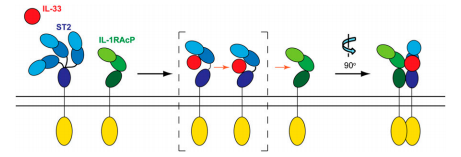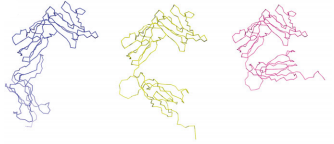Sandbox Reserved 971
From Proteopedia
| Line 36: | Line 36: | ||
Besides, the combination of crystallography and small-angle X-ray-scattering methods reveal that ST2 has a very flexible conformation, contrary to IL-1RAcP. In fact, ST2 is constituted of three IgG-like domains (<scene name='61/614056/Domains_d1d2d3_de_st2/1'>D1 to D3</scene>). D1 and D2 gather to form a single D1D2 module, connected through a linker with the D3 domain. The flexibility of these domains allows ST2 to exist in three different conformers, as you can see on the image below. | Besides, the combination of crystallography and small-angle X-ray-scattering methods reveal that ST2 has a very flexible conformation, contrary to IL-1RAcP. In fact, ST2 is constituted of three IgG-like domains (<scene name='61/614056/Domains_d1d2d3_de_st2/1'>D1 to D3</scene>). D1 and D2 gather to form a single D1D2 module, connected through a linker with the D3 domain. The flexibility of these domains allows ST2 to exist in three different conformers, as you can see on the image below. | ||
| - | [[Image:ST2_conformers.png| | + | [[Image:ST2_conformers.png|600px ]] |
On the left and on the right, there are respectively the open conformer and the close conformer of ST2. On the middle, the half-open conformer is shown. This conformer superimposes perfectly with the conformation of ST2 bound with IL-33. | On the left and on the right, there are respectively the open conformer and the close conformer of ST2. On the middle, the half-open conformer is shown. This conformer superimposes perfectly with the conformation of ST2 bound with IL-33. | ||
Current revision
ST2/IL33 complex
| |||||||||||
References
1. Xi Liua, Michal Hammelb, Yanfeng Hea, John A. Tainerc,d, U-Ser Jenge, Linqi Zhangf, Shuying Wangg, and Xinquan Wanga Structural insights into the interaction of IL-33 with its receptors (2013) DOI: 10.1073/pnas.1308651110
2. Ananda S. Mirchandani, Robert J. Salmond, Foo Y. Interleukin-33 and the function of innate lymphoid cells (2012) DOI: 10.1016/j.it.2012.04.005
3. Rahul Kakkar & Richard T. Lee. The IL-33/ST2 pathway: therapeutic target and novel biomarker (2008) DOI: 10.1038/nrd2660
4. Lécart S, Lecointe N, Subramaniam A, Alkan S, Ni D, Chen R, Boulay V, Pène J, Kuroiwa K, Tominaga S, Yssel H. Activated, but not resting human Th2 cells, in contrast to Th1 and T regulatory cells, produce soluble ST2 and express low levels of ST2L at the cell surface. PMID: 12355452
5. Chia-Lin Hsu and Paul J Bryce. Inducible IL-33 expression by mast cells is regulated by a calcium-dependent pathway. PMCID: PMC3541686


